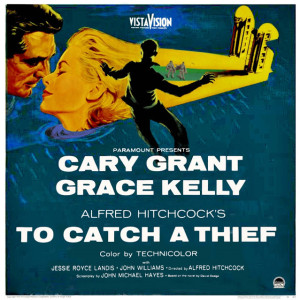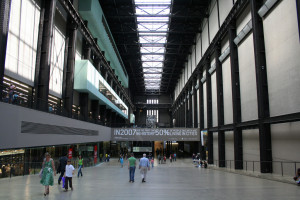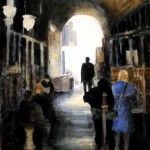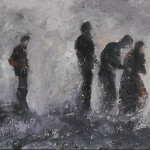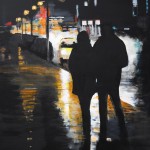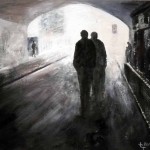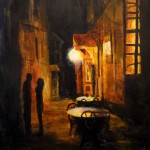I was thirteen when I decided to become an international jewel thief. Like many criminal decisions, mine was made impulsively, and it involved a woman—Grace Kelly. The YMCA in my hometown showed old movies. During an hour and a half in the dark, watching Hitchcock’s To Catch a Thief, I discovered my future life. Grace Kelly and I would live in a chateau overlooking the Mediterranean. We would spend our days stealing jewels while engaging in witty banter. She would be my lover. We would be very sophisticated.
To Catch a Thief is still a great favorite of mine. It was a pleasant surprise when my youngest daughter, Molly, said that she had arranged for us to go to see it at the British Film Institute. The BFI is not as stodgy as the name might suggest. It offers a full bar and great seating. Molly and Liam, her husband, live in London and I was visiting in October of 2012. For the better part of a week we had a wonderful arrangement. Each morning Liam would bring me a cup of tea (so English!) just before he and Molly rushed off to work. The evening we’d made plans about where to meet for dinner the next day. Until then I was entirely free. Having a ‘Tube’ pass and all of London to explore is like being given the keys to The Infinite Possibility Machine, something Douglas Adams might have thought up.
If you are a serious traveler you know that you cannot get the measure of a city until you’ve walked it. With that in mind, and having decided to go to the Tate Modern and its environs, I took the Tube to Waterloo Bridge station and meandered my way along the Thames. Though it isn’t very far from Waterloo Bridge to the Tate, I intended to take my time managing the distance.
London weather is thought by outsiders to be primarily rainy. Londoners will tell you that this is not true. Its dominant characteristic is changeability—sun at ten o’clock, rain at noon, sun at two, strong wind at five, more rain at seven. Being a prudent man, I carried an umbrella with me when I left the flat and had it ready when the sky opened up. It wasn’t much of an umbrella, just something Liam had picked up at Ikea–small and green with large polka dots (he has a sense of whimsy, does Liam). It proved hopelessly inadequate against a wind driven torrent. Having lengthened my trip to the Tate by meandering, I now tried to shorten it with an energetic gallop.
I arrived at the Tate drenched and in a mood as foul as the weather. Entrance to the Tate is free and I strode in, rode the escalator up to the galleries and began glaring at art. Nothing pleased. Nothing could. I gave up and went down to Turbine Hall. Turbine Hall is an immense room with concrete floors, a very high ceiling, and no furniture. The Tate Modern is housed in a former electrical generating plant, and Turbine Hall is where the turbines were once located. Makes sense. It is the place you pass through to get to the galleries. I decided sit on the floor against a wall and sketch the people who were coming and going. The visitors to the museum were strongly back lit by a huge bank of windows. It was amazing how much could be told about people with only a silhouette to work from and with no reference to detail. So the day gave me its first gift—the sketches. They provided the visual idea for a number of paintings and drawings I’ve made since then.
- “London No. 3” 20×16 Acrylic on Illustration board
- Entre Nous 10×8 Pen and Ink wash on d’Arches HP
- “The Wanderers (1)” 24×48 Acrylic on prepared panel
- “Yellow Taxi” 48×40 Acrylic on panel
- London No. 1 16×20 Acrylic on Illustration board
- “Last Table” 30×24 Acrylic on panel
But more was to come.
After a time I was shyly approached by a young woman who asked if she could talk with me. She assured me she was not a panhandler, but rather, an art student working on a project. Her English was good, though slightly accented. Sometimes it had an American inflection. We talked a bit. Her name was Sandra. She was from the Ukraine and was a first year art student. I envied her. She was clearly both exhilarated and frightened. Away from home, studying and living in London, her whole life lay before her. She would probably never again feel as alive as she did now. And the American accented English? She had relatives in the States and spent summers there. She asked me to give her a some items of little value that she might put in her art project. It was an assemblage she was creating from objects gathered from people she met. I gave her a few things including some U.S. coins I had in my pocket. She asked if she could return the quarter and instead take a dime and a penny as they might work better visually. She was definitely artist.
As we were talking a man standing in the middle of the hall began to sing in a kind of melodic chant. There are crazies everywhere, I thought, and tried to take no notice. But then another person started. And another. And another. Sandra leaned back against the wall next to me as we watched. The lights were dimming and brightening as more and more people, men and women, joined the chant. Flash mob? After a few minutes 50 or so people spaced at different parts of the hall were chanting together. Then they began, one by one, to fall silent and leave. Finally, only the man who’d begun was left. The lights darkened and then he too was gone. Sandra rose, thanking me, saying she needed to find others willing to participate in her project.
She was only gone a moment when a man in his 40’s sat down next to me. He immediately began talking in a rapid stream of words about how he lived on a Narrow Boat, a very small Narrow Boat because it was only twenty-six feet long, and his room was a space that was six feet by twelve feet. He had many friends and felt he was very rich and happy, though he had little money. Yes, he’d come to London to find success. He had owned things and lived well, but now all that was gone, no longer a burden, and he was happy. He had the things that counted. I tried to ask him questions, but he talked past them. Finally he shook my hand, thanked me for listening, and walked away.
He joined people who were streaming into the hall. More and more arrived and they began walking about the hall, walking quickly but randomly, almost running into each other at times, then veering off at the last second. Little by little they began to coalesce, to form units and walk in patterns. Several times people walked right at me only to turn just short of a collision. The whole hall seemed alive with moving bodies. The lights rose and fell. The manic movement continued until their numbers began to dwindle. Like the chanters, they too were soon gone.
Suddenly a woman in her twenties dropped to her knees in front of me. Like the man before her, she launched in to a breathless monologue about herself. When she was a girl she used to visit her grandmother in Northumberland. Her grandmother lived in a large drafty house. It was always cold no matter what time of year she went to stay. The worst of it was that the kids had to sleep in this room that was colder than the rest of the house. It was so cold it was called “Siberia”. She used to call it that even though she didn’t know what a Siberia was. The comforters were old and lumpy and heavy, but it was okay because the mattresses were feather mattresses. The weight of the comforter pressed her small body into the softness of the mattress and she felt very warm and safe and wonderful. I begged her to tell me what was going on. She ignored my request several times but as she rose to go she whispered that it was a performance piece called “These Associations” by an artist named Tino Sehgal. These Associations
I had been sitting on the concrete floor so long my butt was numb and my legs were wobbly as I stood to go back into the gallery. I was feeling both at peace and exhilarated with what I’d experienced. From the gallery I could hear the chanting begin again. This time it was slower, more melodic. I was really not in the mood for visual art so I went to one of the balconies that overlook Turbine Hall and watched the performers begin once again to move about the hall. The intricacies of their pattern were more clearly apparent from above. I had dismissed performance art prior to that day, but that is no longer the case. My thoughts often turn to what I experienced and my feelings as I remember them. I’ve thought much about the different implications of Sehgal’s performance piece and my experience as an unwitting participant.
The evening with Molly and Liam continued the enchantment that began at the Tate. We dined at Wahaca, a restaurant housed in conjoined shipping containers, which offers South American inspired cuisine. One of the joys of staying in London with Molly and Liam, is that they know of such places, places I could never find on my own. And, of course, Molly had chosen her film shrewdly. To Catch a Thief worked its magic on me as it always does. I must confess my life as a jewel thief had never worked out. Many years ago I came to grips with the fact that Grace Kelly would never throw herself into the arms of a thirteen year old boy no matter how much jewelry he stole.
PS: Sandra e-mailed me in December with photos of her finished project. She made a fine job of it.
